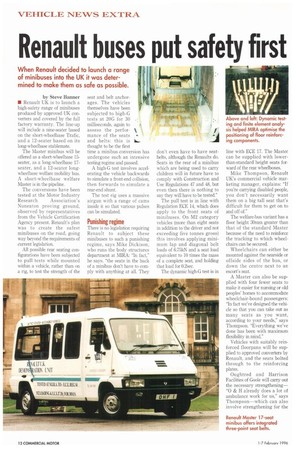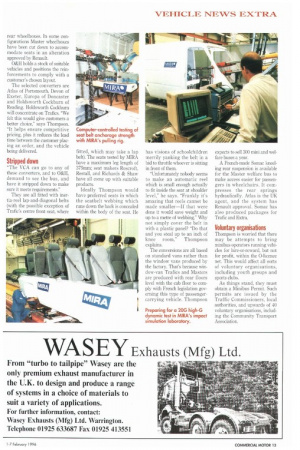Renault buses put safety first
Page 14

Page 15

If you've noticed an error in this article please click here to report it so we can fix it.
When Renault decided to launch a range of minibuses into the UK it was determined to make them as safe as possible.
by Steve Banner • Renault UK is to launch a high-safety range of minibuses produced by approved UK converters and covered by the full factory warranty. The line-up will include a nine-seater based on the short-wheelbase Trafic, and a 12-seater based on its long-wheelbase stablemate.
The Master minibus will be offered as a short-wheelbase 15seater, as a long-wheelbase 17seater, and a 12-seater longwheelbase welfare mobility bus. A short-wheelbase welfare Master is in the pipeline.
The conversions have been tested at the Motor Industry Research Association's Nuneaton proving ground, observed by representatives from the Vehicle Certification Agency present. Renault's plan was to create the safest minibuses on the road, going way beyond the requirements of current legislation.
All possible rear seating configurations have been subjected to pull tests while mounted within a vehicle, rather than on a rig, to test the strength of the seat and belt anchorages. The vehicles themselves have been subjected to high-G tests at 20G for 30 milliseconds, again to assess the performance of the seats and belts: this is thought to be the first time a minibus conversion has undergone such an intensive testing regime and passed.
A high-G test involves accelerating the vehicle backwards to simulate a front-end collision, then forwards to simulate a rear-end shunt.
The test rig uses a massive airgun with a range of cams inside it so that various pulses can be simulated.
Punishing regime
There is no legislation requiring Renault to subject these minibuses to such a punishing regime. says Mike Dickison, who runs the body structures department at MIRA: "In fact," he says. "the seats in the back of a minibus don't have to comply with anything at all. They don't even have to have seatbelts, although the Renaults do. Seats in the rear of a minibus which are being used to carry children will in future have to comply with Construction and Use Regulations 47 and 48, but even then there is nothing to say they will have to be tested."
The pull test is in line with Regulation ECE 14, which does apply to the front seats of minibuses. On M2 category vehicles (more than eight seats in addition to the driver and not exceeding five tonnes gross) this involves applying minimum lap and diagonal belt loads of 6.75kN and a seat load equivalent to 10 times the mass of a complete seat, and holding that load for 0,2sec.
The dynamic high-G test is in line with ECE 17, The Master can be supplied with lowerthan-standard height seats forward of the rear wheelboxes.
Mike Thompson, Renault UK's commercial vehicle marketing manager, explains: "If you're carrying disabled people, you don't necessarily want them on a big tall seat that's difficult for them to get on to and off of."
The welfare-bus variant has a floor height 30mm greater than that of the standard Master because of the need to reinforce the tracking to which wheelchairs can be secured.
Wheelchairs can either be mounted against the nearside or offside sides of the bus, or down the centre next to an escort's seat.
A Master can also be supplied with four fewer seats to make it easier for nursing or old peoples' homes to accommodate wheelchair-bound passengers: "In fact we've designed the vehicle so that you can take out as many seats as you want, according to your needs," says Thompson. "Everything we've done has been with maximum flexibility in mind."
Vehicles with suitably reinforced floorpans will be supplied to approved converters by Renault, and the seats bolted through to the reinforcing plates.
Oughtred and Harrison Facilities of Goole will carry out the necessary strengthening& H already does a lot of ambulance work for us," says Thompson—which can also involve strengthening for the rear wheelboxes. In some configurations Master wheelboxes have been cut down to accommodate seats in an alteration approved by Renault.
O&H holds a stock of suitable vehicles and positions the reinforcements to comply with a customer's chosen layout.
The selected converters are Atlas of Portsmouth, Devon of Exeter, Europa of Doncaster and Holdsworth Cockburn of Reading. Holdsworth Cockburn will concentrate on Trafics. "We felt this would give customers a better choice," says Thompson. "It helps ensure competitive pricing, plus it reduces the lead time between the customer placing an order, and the vehicle being delivered.
Stripped down
The VCA can go to any of these converters, and to O&H, demand to see the bus, and have it stripped down to make sure it meets requirements." They are all fitted with inertia-reel lap-and-diagonal belts (with the possible exception of Trafic's centre front seat, where fitted, which may take a lap belt). The seats tested by MIRA have a maximum leg length of 375mm; seat makers Rescroft, Resta11, and Richards & Shaw have all come up with suitable products.
Ideally Thompson would have preferred seats in which the seatbelt webbing which runs down the back is concealed within the body of the seat. He has visions of schoolchildren merrily yanking the belt in a bid to throttle whoever is sitting in front of them.
"Unfortunately nobody seems to make an automatic reel which is small enough actually to fit inside the seat at shoulder level," he says. "Frankly it's amazing that reels cannot be made smaller—If that were done it would save weight and up to a metre of webbing." Why not simply cover the belt in with a plastic panel? "Do that and you steal up to an inch of knee room," Thompson explains.
The conversions are all based on standard vans rather than the window vans produced by the factory. That's because window-van Trafics and Masters arc produced with rear floors level with the cab floor to comply with French legislation governing this type of passenger carrying vehicle. Thompson expects to sell 300 mini and welfare buses a year.
A French-made Somac kneeling rear suspension is available for the Master welfare bus to make access easier for passengers in wheelchairs. It compresses the rear springs hydraulically. Atlas is the UK agent, and the system has Renault approval. Somac has also produced packages for Trafic and Extra.
Voluntary organisations
Thompson is worried that there may be attempts to bring minibus operators running vehicles for hire-or-reward, but not for profit, within the 0-licence net. This would affect all sorts of voluntary organisations, including youth groups and sports clubs.
As things stand, they must obtain a Minibus Permit. Such permits are issued by the Traffic Commissioners, local authorities, and upwards of 40 voluntary organisations, including the Community Transport Association.
































































































